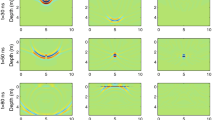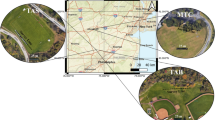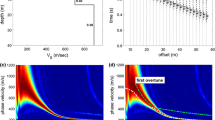Abstract
There are various types of multiples associated with ground-penetrating radar, with complex propagation paths, which seriously affects the identification of primary waves and profile interpretation. In this paper, the response of each type of multiple in velocity-increasing horizontal laminar media is systematically simulated by the ray-tracing method, the multiple travel time difference characteristics, reflection coefficient characteristics, velocity characteristics and influencing factors are analysed, and the multiple categories in the field data are identified. The numerical simulation results show that the travel time differences of multiples exhibit time and spatial variation characteristics and autocorrelation energy dispersion at far offset distances. The first-layer bottom multiples and the first-layer bottom primary wave, other surface-related multiples and the second-layer bottom primary wave, and reverberation and internal multiples have similar reflection coefficient characteristics. The velocity of internal multiples is the highest, the velocity of the second-layer bottom multiples is higher than that of the reverberation and other surface-related multiples, and the velocity of low-order multiples is higher than that of high-order multiples; the first-layer bottom multiples have the same propagation velocity as the first-layer bottom primary wave. The stratigraphic combination, electrical parameters of the medium, polarization mode of the antenna and field acquisition method all affect the multiple energy. This study can provide a theoretical basis for multiple identification, removal and profile interpretation.














Similar content being viewed by others
References
Alhumimidi, M. S., Harbi, H. M., Alfarhan, M. S., Abdelrahman, K., & Aiken, C. L. V. (2017). Imaging fracture distributions of the Al-Khuff Formation outcrops using GPR and ERT geophysical techniques, Al-Qassim area, Saudi Arabia. Arabian Journal of Geosciences, 10, 306–316. https://doi.org/10.1007/s12517-017-3059-0
Al-Khersan, E. H., Al-Ani, J. M. T., & Abrahem, S. N. (2016). Integrated GPR and ERT as Enhanced Detection for Subsurface Historical Structures Inside Babylonian Houses Site, Uruk City. Southern Iraq. Pure and Applied Geophysics, 173(3), 963–982. https://doi.org/10.1007/s00024-015-1162-2
Caorsi, S., & Stasolla, M. (2012). Towards the detection of multiple reflections in time-domain em inverse scattering of multi-layered MeDIA. Progress in Electromagnetics Research B, 38, 351–365.
Diallo, M. C., Cheng, Z., Rosa, E., Gunther, C., & Chouteau, M. (2018). Integrated GPR and ERT data interpretation for bedrock identification at Cléricy, Québec, Canada. Engineering Geology. https://doi.org/10.1016/j.enggeo.2018.09.011
Jeng, Y., Lin, C., Li, Y., Chen, C., & Yu, H. (2011). Application of sub-image multiresolution analysis of Ground-penetrating radar data in a study of shallow structures. Journal of Applied Geophysics, 73(3), 251–260. https://doi.org/10.1016/j.jappgeo.2011.01.007
Kofman, L., Ronen, A., & Frydman, S. (2006). Detection of model voids by identifying reverberation phenomena in GPR records. Journal of Applied Geophysics, 59(2006), 284–299. https://doi.org/10.1016/j.jappgeo.2005.09.005
Lai, W. W. L., Chang, R. K. W., & Sham, J. F. C. (2017). Detection and imaging of city’s underground void by GPR. 2017 9th International Workshop on Advanced Ground Penetrating Radar (IWAGPR) (pp. 1–6). IEEE.
Lu, C. M., Qin, Z., Zhu, H. L., & Li, X. Z. (2007). Practical methods for detection of concealed cracks in highway pavement using ground penetration radar data. Chinese Journal of Geophysics, 50(5), 1558–1568.
Mahmoudzadeh, M. R., Francés, A. P., Lubczynski, M., & Lambot, S. (2012). Using ground penetrating radar to investigate the water table depth in weathered granites—Sardon case study, Spain. Journal of Applied Geophysics, 79, 17–26. https://doi.org/10.1016/j.jappgeo.2011.12.009
Nobes, D. C., Davis, E. F., & Arcone, S. A. (2005). “Mirror-image” multiples in ground-penetrating radar. Geophysics, 70(1), K20–K22. https://doi.org/10.1190/1.1852781
Nuzzo, L. (2005). Identification and removal of above-ground spurious signals in GPR archaeological prospecting. Archaeological Prospection, 12, 93–103. https://doi.org/10.1002/arp.250
Odah, H., Ismail, A., Elhemaly, I., Anderson, N., Abbas, A. M., Shaaban, F. (2013). Archaeological exploration using magnetic and GPR methods at the first court of Hatshepsut Temple in Luxor Egypt. Arabian Journal of Geosciences, 6(3), 865–871. https://doi.org/10.1007/s12517-011-0380-x
Rizzo, E., Capozzoli, L., De Martino, G., & Grimaldi, S. (2019). Urban geophysical approach to characterize the subsoil of the main square in San Benedetto del Tronto town (Italy). Engineering Geology, 257(2019), 105–133. https://doi.org/10.1016/j.enggeo.2019.05.010
Schmalz, B., Lennartz, B., & Wachsmuth, D. (2002). Analyses of soil water content variations and GPR attribute distributions. Journal of Hydrology, 267(2002), 217–226.
Sevil, J., Gutiérrez, F., Zarroca, M., Desir, G., Carbonel, D., Guerrero, J., & Fabregat, I. (2017). Sinkhole investigation in an urban area by trenching in combination with GPR, ERT and high-precision leveling. Mantled evaporite karst of Zaragoza city, NE Spain. Engineering Geology. https://doi.org/10.1016/j.enggeo.2017.10.009
Wang, Y., Qian, R., & Lu, X. (2017). The study of ground penetrating radar multiple wave characteristics and supression method. In: SAGEEP2017, Denver, Colorado USA, pp. 135–138.
Wu, J., Lin, H., Lee, D., & Fang, S. (2005). Integrity assessment of rock mass behind the shotcreted slope using thermography. Engineering Geology, 80(2005), 164–173. https://doi.org/10.1016/j.enggeo.2005.04.005
Xu, X., Zeng, Q., Li, D., Wu, J., Wu, X., & Shen, J. (2010). GPR detection of several common subsurface voids inside dikes and dams. Engineering Geology, 111(2010), 31–42. https://doi.org/10.1016/j.enggeo.2009.12.001
Zhao, W., Forte, E., & Pipan, M. (2016). Texture attribute analysis of GPR data for archaeological prospection. Pure and Applied Geophysics, 173(8), 2737–2751. https://doi.org/10.1007/s00024-016-1355-3
Zhao, W., Forte, E., Pipan, M., & Tian, G. (2013). Ground Penetrating Radar (GPR) attribute analysis for archaeological prospection. Journal of Applied Geophysics, 97, 107–117. https://doi.org/10.1016/j.jappgeo.2013.04.010
Acknowledgements
The authors would like to acknowledge the considerable support by the general projects of the National Natural Science Foundation of China (Nos. 41374116 and 41674113) and the Scientific and Technological Research Project of Anhui Province and Huaihe River Water Resources Institute (No. KJGG202002).
Funding
General projects of the National Natural Science Foundation of China, 41374116, Scientific and Technological Research Project of Anhui Province and Huaihe River Water Resources Institute, KJGG202002
Author information
Authors and Affiliations
Contributions
Kuiye Wei and Hongbing Zhang wrote the main manuscript text. All authors reviewed the manuscript.
Corresponding author
Ethics declarations
Competing interests
The authors declare no competing interests.
Conflict of interest
The authors declare that they have no known competing financial interests or personal relationships that could have appeared to influence the work reported in this paper.
Additional information
Publisher's Note
Springer Nature remains neutral with regard to jurisdictional claims in published maps and institutional affiliations.
Rights and permissions
Springer Nature or its licensor (e.g. a society or other partner) holds exclusive rights to this article under a publishing agreement with the author(s) or other rightsholder(s); author self-archiving of the accepted manuscript version of this article is solely governed by the terms of such publishing agreement and applicable law.
About this article
Cite this article
Wei, K., Zhang, H., Zhu, S. et al. Characteristics of Multiples in GPR Surveys and the Influencing Factors in Horizontal Strata. Pure Appl. Geophys. 179, 4595–4607 (2022). https://doi.org/10.1007/s00024-022-03170-1
Received:
Revised:
Accepted:
Published:
Issue Date:
DOI: https://doi.org/10.1007/s00024-022-03170-1




